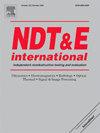基于快速激励扫描算法的aca加速Nyström方法在CBIE中对三维超声无损检测问题进行高效建模
IF 4.5
2区 材料科学
Q1 MATERIALS SCIENCE, CHARACTERIZATION & TESTING
引用次数: 0
摘要
本文提出了一种高效的纯代数核无关算法——自适应交叉逼近(ACA)算法,通过加速采用高阶Nyström方法(NM)离散化的传统边界积分方程(CBIE),对三维超声无损评价(UNDE)问题进行建模。构建八叉树结构,将被测三维物体细分为小的子块,然后根据子块之间的距离将其划分为对角线、近块和远块。与边界元法(BEM)不同,NM基于高斯正交选择插值节点,大大简化了处理奇异点和近奇异点的过程,并且在计算远块相互作用的矩阵元素时无需进行显式积分。然后应用ACA算法加速求解由NM离散的矩阵,将计算复杂度降低到O(NlogN)。它还可以作为快速激励扫描算法,扫描大量的入射场,将多个右侧(RHS)向量的求解时间减少99.7%,这对于处理不确定性传播等问题特别有用,其中需要模拟大量输入激励。最后,利用傅里叶反变换和Auld互易公式,将离散化后的多个rss方程在频域得到的散射幅值转换为时域电压信号。通过浸入式测试基准问题验证了该方法的准确性和有效性。本文章由计算机程序翻译,如有差异,请以英文原文为准。
ACA-accelerated Nyström method with fast excitation sweep algorithm for efficient modeling of 3D ultrasonic NDE problems using CBIE
In this paper, an efficient pure algebraic and kernel independent algorithm, the adaptive cross approximation (ACA) algorithm, is developed for modeling three-dimensional (3D) ultrasonic non-destructive evaluation (UNDE) problems by accelerating conventional boundary integral equations (CBIE) which is discretized using the high order Nyström method (NM). The octree structure is constructed to subdivide the 3D object under test into small sub-blocks, which are then classified into diagonal, near and far blocks determined by the distances among them. Unlike boundary element method (BEM), NM selects the interpolation nodes based on Gaussian quadrature, which substantially simplifies the process of dealing with the singularities and near-singularities, and removes the necessities of performing explicit integration in the calculation of matrix elements for far block interactions. The ACA algorithm is then applied to accelerate solving the matrix discretized by NM, reducing the computational complexity to O(NlogN). It also works as the fast excitation sweep algorithm for sweeping across a large number of incident fields, reducing solution time for multiple right-hand-side (RHS) vectors by up to 99.7 %, which is especially useful for dealing with problems such as uncertainty propagation wherein a large number of input excitations need to be simulated. Finally, the scattering amplitudes obtained in frequency domain by solving the discretized equation with multiple RHSs are converted into voltage signals in time domain using inverse Fourier transform and Auld's reciprocity formulas. The accuracy and efficiency of the proposed method are demonstrated using immersion testing benchmark problems.
求助全文
通过发布文献求助,成功后即可免费获取论文全文。
去求助
来源期刊

Ndt & E International
工程技术-材料科学:表征与测试
CiteScore
7.20
自引率
9.50%
发文量
121
审稿时长
55 days
期刊介绍:
NDT&E international publishes peer-reviewed results of original research and development in all categories of the fields of nondestructive testing and evaluation including ultrasonics, electromagnetics, radiography, optical and thermal methods. In addition to traditional NDE topics, the emerging technology area of inspection of civil structures and materials is also emphasized. The journal publishes original papers on research and development of new inspection techniques and methods, as well as on novel and innovative applications of established methods. Papers on NDE sensors and their applications both for inspection and process control, as well as papers describing novel NDE systems for structural health monitoring and their performance in industrial settings are also considered. Other regular features include international news, new equipment and a calendar of forthcoming worldwide meetings. This journal is listed in Current Contents.
 求助内容:
求助内容: 应助结果提醒方式:
应助结果提醒方式:


